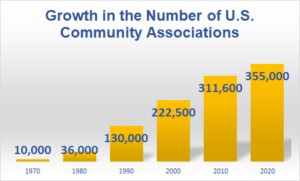The number of new condominium communities and homeowners associations is expected to increase by 5,000 in 2022, according to projections by the Foundation for Community Association Research, an affiliate organization of Community Associations Institute (CAI). Community associations, also known as homeowners associations, condominiums, and housing cooperatives, are home to 74.1 million Americans and will represent between 25–27% of the U.S. housing stock. A full scope of industry data and statistics will be released in July 2022.
“Several variables are influencing trends in the community association housing market,” says Dawn M. Bauman, CAE, executive director of the Foundation and CAI’s senior vice president of government and public affairs. “We’re witnessing a strong rental market, preferred by younger homeowners seeking noncommittal housing options rather than homeownership. This trend is incentivizing developers to choose apartment development over condominium development.”
Bauman adds that the demand for housing is outpacing the number of sellers in many cities, especially as mortgage rates remain historically low. “Community association housing experts are optimistic about the new home construction predictions, while closely examining how homeownership preferences and the persistent supply chain and labor shortages could disrupt growth.”
Since the 1970s, community associations have been a popular housing choice for people around the world—especially for condominium buyers seeking proximity to city centers, public transportation, and schools. The 2020 U.S. Census data show that 65% of new single-family homes were built in a community association. These planned communities provide numerous benefits to owners including shared amenities such as pools, walking trails, and other recreational facilities, protected property values, and a strong sense of community.
Planned communities also give local municipalities the ability to transfer the obligation of providing services such as trash and recycling pickup, snow removal, sidewalk and street maintenance and lighting, stormwater management, and more to the homeowners, according to the Foundation’s 2020-2021 U.S. National and State Statistical Review for Community Association Data.
“Condominiums, homeowners associations, and housing cooperatives play a significant role in America’s housing stock,” says Thomas M. Skiba, CAE, CAI’s chief executive officer. “Following the June 24 tragedy of the Champlain Towers South condominium collapse, we’ve focused on supporting governance and professional advice related to maintenance reserve funding and building safety. Volunteer board members, professional community managers, and industry professional service providers are committed to working with legislators to protect their communities.”
The 2020 Homeowner Satisfaction Survey, a biennial, nationwide report conducted by Zogby Analytics on behalf of the Foundation, provides a better understanding of condominiums and homeowners associations. Homeowners say the following about their community association living experience:
- 89% rate their overall experience as very good or good (70%) or neutral (19%).
- 89% say members of their elected governing board “absolutely” or “for the most part” serve in the best interests of their community.
- 74% say their community manager provides value and support to residents and their association.
- 94% say their association’s rules protect and enhance property values (71%) or have a neutral effect (23%); only 4% say the rules harm property values.
For more information on community association statistics, visit the Community Association Fact Book.



